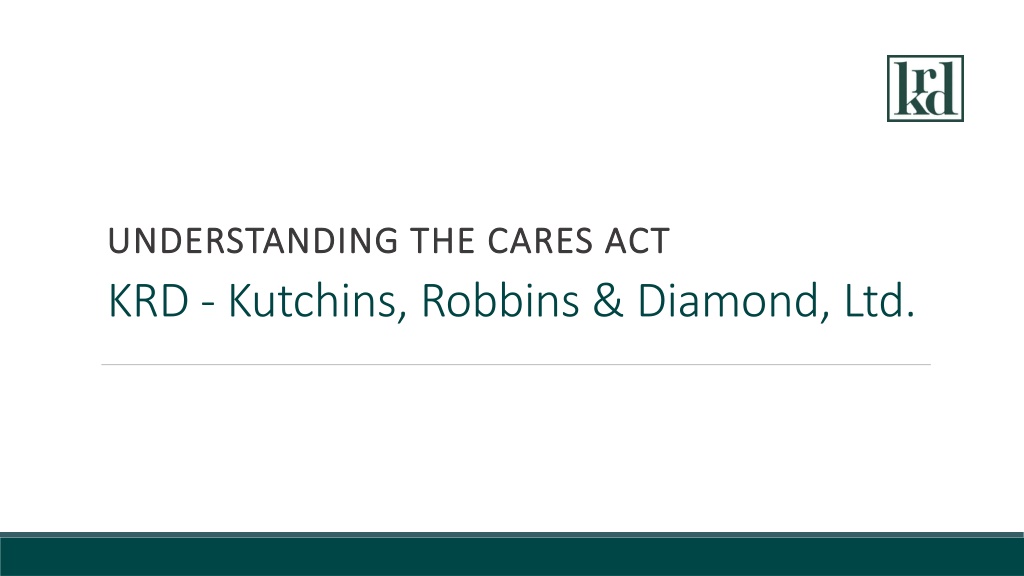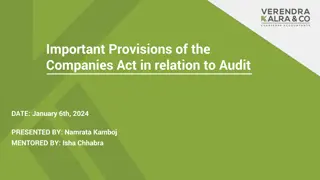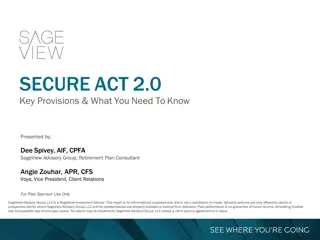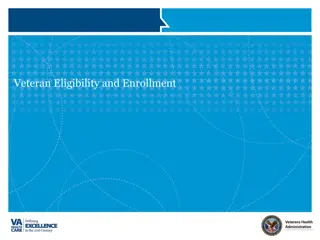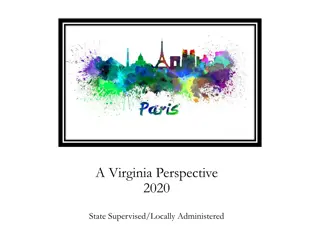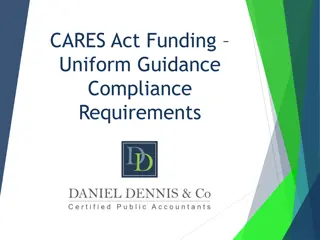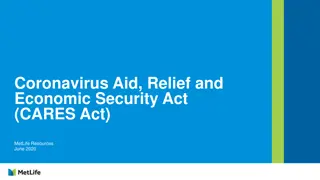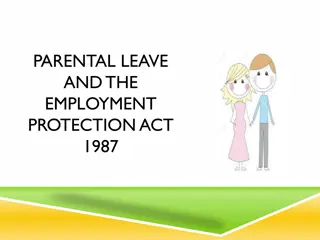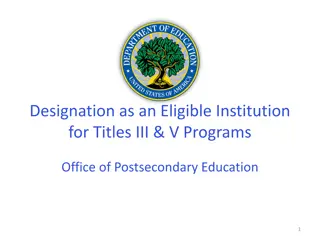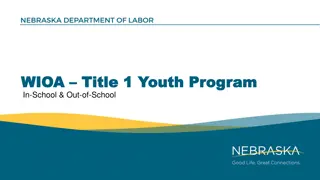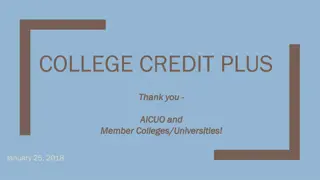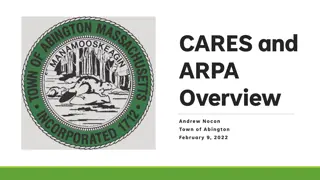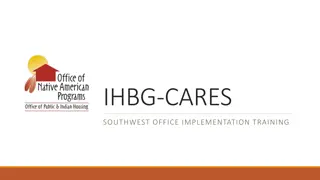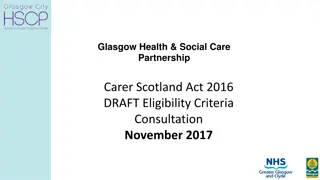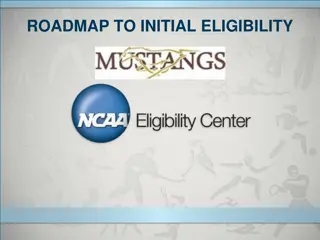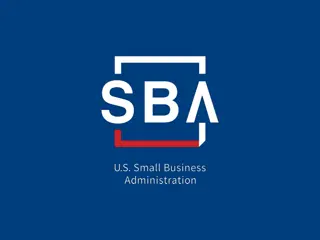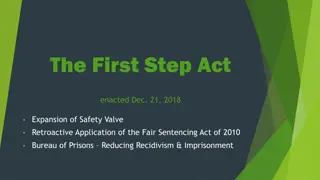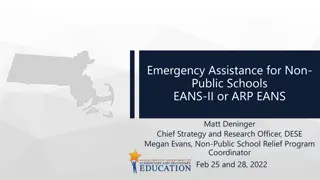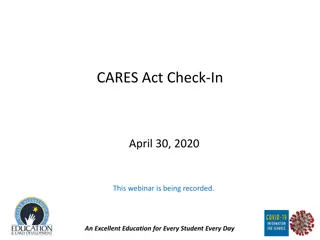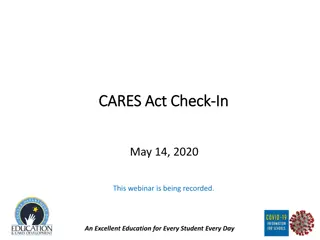Understanding the CARES Act: Key Provisions and Eligibility Criteria
The CARES Act encompasses significant economic stimulus measures to aid businesses during the COVID-19 crisis. It includes the Paycheck Protection Program (PPP) and Economic Injury Disaster Loans (EIDL), offering forgivable loans to qualifying businesses. Eligibility criteria, loan amounts, and key details are outlined, providing essential insights for businesses seeking financial assistance.
Uploaded on Sep 25, 2024 | 0 Views
Download Presentation

Please find below an Image/Link to download the presentation.
The content on the website is provided AS IS for your information and personal use only. It may not be sold, licensed, or shared on other websites without obtaining consent from the author. Download presentation by click this link. If you encounter any issues during the download, it is possible that the publisher has removed the file from their server.
E N D
Presentation Transcript
UNDERSTANDING THE CARES ACT UNDERSTANDING THE CARES ACT KRD - Kutchins, Robbins & Diamond, Ltd.
Gene Barinholtz, CPA - Partner Gene has been in public accounting for over 30 years Specialties: Tax strategies, tax incentives and entitlements Business consulting and litigation support
Paul Wilkin, CPA - Manager Paul has been in public accounting for over 30 years Specialties: Small to medium-sized businesses, established companies, and start-ups
The CARES Act Congress has recently enacted two sweeping economic stimulus laws related to the coronavirus threat. 1. Families First Coronavirus Recovery Act (FFCRA), which contains two major provisions: A. Emergency Paid Sick Leave Act B. Emergency Family and Medical Leave Expansion Act 2. The Coronavirus Aid, Relief, and Economic Security (CARES) Act PPP Loans EIDL Payroll tax credit provisions These provisions are aimed at encouraging businesses to maintain workers on their payrolls by providing immediate, short-term financing and access to cash flow through tax credits and expanded SBA assistance programs. Even as of this date there are several provisions of this program that the SBA has yet to define. This presentation is current as of April 15, 2020.
The SBA Paycheck Protection Program ( PPP ) & Economic Injury Disaster Loans (EIDL)
Who Qualifies? PPP Loans rolled out for businesses on 4/3/20. This is a new class of forgivable loans for businesses that meet the following criteria: Any business, nonprofit organization (501 (c)(3)), veterans organization or Tribal business concern that: o Was in operation as of February 15, 2020; o Employs no more than 500 employees o Paid employees (Independent Contractors are NOT a part of the PPP calculation); o Makes a good faith certification that the uncertainty of current economic conditions makes the loan request necessary to support ongoing operations. Sole proprietorships, independent contractors, and self-employed individuals are eligible. Their loan application program launched 4/10/20. A business that obtained an SBA Disaster Recovery loan after January 31, 2020 is allowed to refinance that loan and roll it into a PPP loan. Only one PPP loan is allowed per borrower.
How Much Can I Receive? The maximum PPP loan available is the lesser of: $10 million or 2.5 times the average monthly payroll costs for the previous 12 months plus any EIDL used for payroll o Payroll costs include: Salaries, wages, commissions, tips, vacation pay, family or medical or sick leave pay, separation pay (including PEO and similar arrangements); Group health care benefits including insurance premiums; Retirement benefits; State and local taxes assessed on employee compensation (SUTA); Payments to independent contractors are NOT a part of payroll costs. Partners in a partnership are included in the Payroll costs of the partnership.
How Much Can I Receive? (Cont.) o Annual compensation to any individual is limited to $100,000 (including self- employed). Based on SBA guidance issued 4/6/20 (Question 7) only the wage portion is limited to $100,000. (2019 or trailing 12 months) o Seasonal businesses use the average monthly payroll costs for the 12-week period beginning either February 15, 2019 or March 1, 2019 (chosen by the borrower). o Businesses not operational in 2019 use the average monthly payroll costs for January and February 2020. o Payroll costs do not include any amounts for which a credit is allowed under the Families First Coronavirus Response Act. o Payments must be made to US residents. o It is the borrowers responsibility to accurately calculate the payroll costs.
What Can I Use the Money For? PPP loans can be used to pay: o Payroll costs; o Group healthcare continuation costs for employees on paid sick, family or medical leave; o Mortgage interest on loans incurred prior to February 15, 2020; o Rent or leases in existence prior to February 15, 2020; o Utilities, phone and internet access for services begun prior to February 15, 2020; o Interest on any other debt obligations incurred prior to February 15, 2020. (This is true but this portion is not forgivable) o Refinance an EIDL loan made between 1/31/20-4/3/20.
What Counts as Payroll Costs? GROSS Salary, wages, commissions, or tips (capped at $100,000 on an annualized basis for each employee) less FICA and Taxes Withheld 2/15/20-6/30/20 Employee benefits including costs for vacation, parental, family, medical, or sick leave; allowance for separation or dismissal; payments required for the provisions of group health care benefits including insurance premiums; and payment of any retirement benefit; State and local taxes assessed on compensation (state unemployment tax); and For a sole proprietor or independent contractor: wages, commissions, income, or net earnings from self-employment, capped at $100,000 on an annualized basis for each employee. Partners in a partnership are employees at the partnership level.
What Are the Loan Terms? The interest is 1.0%. The loan term is 2 years. No payments of principal or interest for six months interest accrues during the deferment period. No personal guarantees required. Not based on creditworthiness No collateral required. No SBA or bank fees.
How Much of My Loan Will Be Forgiven? You must spend the loan proceeds over an 8 week period beginning when the loan is funded. You will owe money when your loan is due if you use the loan amount for anything other than payroll costs, mortgage interest, rent, and utilities payments over the 8 weeks after getting the loan or if you do not use the funds within the 8 week period. At least 75% of the loan proceeds MUST be used for payroll costs. If you received an emergency grant under the EIDL program and roll it into the PPP program an amount equal to the EIDL emergency grant is NOT forgivable for the PPP loan. THE AMOUNT THAT IS FORGIVEN WILL NOT BE TAXABLE INCOME You will also owe money if you do not maintain your staff and payroll. Number of Staff: Your loan forgiveness will be reduced if you decrease your average full-time employee headcount over a base period and do not restore your headcount by 6/30/20. Level of Payroll: Your loan forgiveness will also be reduced if you decrease salaries and wages by more than 25% for any employee that made less than $100,000 annualized in 2019. Re-Hiring: You have until June 30, 2020 to restore your full-time employment and salary levels for any changes made between February 15, 2020 and April 26, 2020.
How Can I Request Loan Forgiveness? You will submit a request to the lender that is servicing the loan. The request will include documents that verify the number of full-time equivalent employees and pay rates, as well as the payments on eligible mortgage, lease, and utility obligations. You must certify that the documents are true and that you used the forgiveness amount to keep employees and make eligible mortgage interest, rent, and utility payments. The SBA has yet to issue final guidance on the required documentation. You must PROACTIVELY make the request for forgiveness. This is NOT automatic. The lender must make a decision on the forgiveness within 60 days.
How Do I Get a PPP Loan? The loans will be disbursed through federally insured banks and credit unions, institutions of the Farm Credit System and other specialized lenders. The loans will be 100% guaranteed by SBA, so there is no underwriting risk for the banks. Normal SBA lending criteria do not apply to these loans. Loan requests under this program are being taken through 6/30/20 or when the funds are exhausted whichever is earlier. $349B first come, first served. Additional funding for the PPP program is being discussed but no action has been taken as of 4/15/20. The program is intended to require very little documentation for underwriting purposes. At a minimum, applicants should have records of payroll costs, lease or mortgage payments and utility payments for the preceding twelve months, as well as organizational documents to prove existence prior to February 15, 2020. Additional documentation may be necessary as requested by your lender.
Paycheck Protection Program (PPP) Sample Application Form
Link to view full sample form https://www.sba.gov/docu ment/sba-form--paycheck- protection-program- borrower-application-form
Likely List of Documents Needed for Lender Appropriate tax returns of the business usually 941 s; Documents reflecting the number of employees; Documents showing health insurance costs (employer share only); Documents showing retirement plan costs (employer share only); Documents showing mortgage obligations; Lease agreements and Documents showing utilities costs.
Economic Injury Disaster Loans (EIDL) The EIDL loans offer up to $2 million for working capital needs such as fixed debt and payroll and operating expenses UP TO a 30-year term: 3.75% for businesses 2.75% for nonprofits No personal guarantee for loans up to $200,000. Collateral IS not necessary but required if you have it loans over $25K. There is an automatic one-year deferment on repayment so the first payment is not due for a full year, although interest begins to accrue at time of disbursement
EIDL Grant: Up to $10,000 If you apply for an EIDL loan, you can request a $1,000 per employee emergency grant (up to $10,000 total) for working capital If you qualify, the grant is available even if you apply for a PPP loan. If you do apply for a PPP loan, it will not reduce your PPP loan amount However, the grant will be subtracted from the amount of your PPP loan forgiveness, and you will have to repay the grant amount over two years Make sure you apply for the grant on the SBA website. Click here to access the application. KRD also has recommendations for completing the EIDL application, which can be found here.
Payroll Tax Deferral The CARES Act allows employers to defer the payment of payroll taxes incurred between March 27, 2020 and December 31, 2020 The deferral applies to the employer portion of social security taxes (6.2% of employer wages up to $137,700) and the employer s and employee s share of Tier 1 Railroad Retirement Tax Act tax up to the 6.2% of wages that corresponds with the social security tax Self-employed individuals may also defer 6.2% of self-employment taxes incurred during this period Federal withholding taxes, Medicare taxes and withholding, and employee social security withholding are not eligible for the deferral
Payroll Tax Deferral (Cont.) The deferred taxes are due and considered timely paid if 50% of the amount deferred is paid by December 31, 2021 and the remaining 50% deferred amount is paid by December 31, 2022 All employers are eligible for the deferral except those who have loans forgiven under the SBA Payroll Protection Program. An employer who receives a PPP loan may take advantage of this payroll tax deferral up until the date their lender notifies them of loan forgiveness.
Employee Retention Credit for Employers Subject to COVID-19 (Cont.) Eligible employers are allowed a credit against payroll taxes for 50% of the qualified wages of an eligible employee for wages paid from March 13, 2020 to December 31, 2020 Self-employed individuals are not eligible for this credit for their self-employment services or earnings The maximum amount of qualified wages taken into account per employee for all calendar quarters is $10,000. Therefore, the maximum credit is $5,000 per employee. The credit is refundable if it exceeds the employer s social security or Railroad Retirement Tax due in a quarter
Employee Retention Credit for Employers Subject to COVID-19 (Cont.) To be considered an eligible employer, employers must meet one of two criteria: 1. The employer s operations must be fully or partially suspended during the calendar quarter as a result of orders from an appropriate government authority limiting commerce, travel, or group meetings due to COVID 19; or 2. The employer experiences a significant decline in gross receipts during the calendar quarter. A significant decline in gross receipts begins with the first quarter in which an employer s gross receipts for a calendar quarter in 2020 are less than 50 percent of its gross receipts for the same calendar quarter in 2019. The significant decline in gross receipts ends with the first calendar quarter that follows the first calendar quarter for which the employer s 2020 gross receipts for the quarter are greater than 80 percent of its gross receipts for the same calendar quarter during 2019.
Employee Retention Credit for Employers Subject to COVID-19 (Cont.) EXAMPLE An employer s gross receipts were $100,000, $190,000, and $230,000 in the first, second, and third calendar quarters of 2020, respectively. Its gross receipts were $210,000, $230,000, and $250,000 in the first, second, and third calendar quarters of 2019, respectively. Thus, the employer s 2020 first, second, and third quarter gross receipts were approximately 48%, 83%, and 92% of its 2019 first, second, and third quarter gross receipts, respectively. Accordingly, the employer had a significant decline in gross receipts commencing on the first day of the first calendar quarter of 2020 (the calendar quarter in which gross receipts were less than 50% of the same quarter in 2019) and ending on the first day of the third calendar quarter of 2020 (the quarter following the quarter for which the gross receipts were more than 80% of the same quarter in 2019). Thus the employer is entitled to a retention credit with respect to the first and second calendar quarters.
Employee Retention Credit for Employers Subject to COVID-19 (Cont.) What are qualified wages? If the employer averaged more than 100 full-time employees in 2019, qualified wages are the wages paid to an employee for time that the employee is not providing services due to the economic hardship described in (1) and (2) previously. Qualified wages for an employee may not exceed what the employee would have been paid for working an equivalent duration during the 30 days immediately preceding the period of economic hardship. If the employer averaged 100 or fewer full-time employees in 2019, qualified wages are the wages paid to any employee during any period of economic hardship described in (1) and (2) previously. Full-time employee = 30 hours per week or more. Full-time equivalents (FTEs) must be calculated based on the 30 hour standard as well.
Employee Retention Credit for Employers Subject to COVID-19 (Cont.) Claiming the credit: The credit will be claimed on Form 941 for the applicable quarter. However, the employer does not have to wait until after the end of the quarter to realize a benefit. Reduce payroll tax deposits hold onto your cash. File IRS Form 7200 Advance Payment of Employer Credits Due to COVID-19. Any company that receives a PPP loan may not claim the ERC.
Employee Retention Credit for Employers Subject to COVID-19 (Cont.) Claiming the credit:
Families First Coronavirus Recovery Act Emergency Paid Sick Leave Act Employers with fewer than 500 employees are required to provide paid sick time to the extent that the employee is unable to work or telework due to a need for leave because: 1. The employee is subject to a federal, state or local quarantine or isolation order related to COVID-19; 2. The employee has been advised by a health care provider to self-quarantine due to concerns related to COVID-19; 3. The employee is experiencing symptoms of COVID-19 and seeking a medical diagnosis; 4. The employee is caring for an individual who is subject to an order described in item 1 above or has been advised as described in 2 above;
Families First Coronavirus Recovery Act Emergency Paid Sick Leave Act 5. The employee is caring for a son or daughter if the school or place of care of their child has been closed, or the child care provider for their child is unavailable due to COVID-19 precautions; 6. The employee is experiencing any other substantially similar condition specified by the federal government. The employer is allowed a credit against wages paid for sick leave described above. If an individual is on sick leave due to circumstances 1), 2), or 3) above, then their wages taken into account are limited to $511 per day. If an individual is on sick leave due to circumstances 4), 5), or 6) above, then their wages taken into account are limited to $200 per day. The credit is calculated over a maximum of 10 days. The credit amount may be increased by a pro rata portion of the employer s qualified health plan expenses allocable to those wages.
Families First Coronavirus Recovery Act Emergency Paid Sick Leave Act Self-employed individuals are also eligible for this refundable credit. The calculation of the daily dollar amount limitation may differ slightly. The wages included in the credit calculation, along with the health care costs, will be added back to the employer s income for income tax purposes. Note that wages included for purposes of this credit may not be included for purposes of other credits such as the Credit for Increasing Research Activities against income tax.
Families First Coronavirus Recovery Act Emergency Paid Sick Leave Act What does an employee need to provide? Per IRS guidance: An Eligible Employer will substantiate eligibility for the sick leave or family leave credits if the employer receives a written request for such leave from the employee in which the employee provides: 1.The employee s name; 2.The date or dates for which leave is requested; 3.A statement of the COVID-19 related reason the employee is requesting leave and written support for such reason; and 4.A statement that the employee is unable to work, including by means of telework, for such reason. In the case of a leave request based on a quarantine order or self-quarantine advice, the statement from the employee should include the name of the governmental entity ordering quarantine or the name of the health care professional advising self-quarantine, and, if the person subject to quarantine or advised to self-quarantine is not the employee, that person s name and relation to the employee. In the case of a leave request based on a school closing or child care provider unavailability, the statement from the employee should include the name and age of the child (or children) to be cared for, the name of the school that has closed or place of care that is unavailable, and a representation that no other person will be providing care for the child during the period for which the employee is receiving family medical leave and, with respect to the employee s inability to work or telework because of a need to provide care for a child older than fourteen during daylight hours, a statement that special circumstances exist requiring the employee to provide care.
Families First Coronavirus Recovery Act Emergency Family and Medical Leave Expansion Act Employers with fewer than 500 employees are required to provide paid family and medical leave to the extent that the employee is unable to work or telework due to a need for leave to care for a son or daughter under the age of 18 because: o The school or place of care has been closed because of COVID-19 concerns; or o The child care provider is unavailable due to COVID-19 concerns. o Basically #5 above. The first 10 days of FML leave may be unpaid, after which paid leave is required. The sick leave provisions may be applied to this 10-day period.
Families First Coronavirus Recovery Act Emergency Family and Medical Leave Expansion Act Employers are allowed a credit for a maximum of $200 per day, up to a total maximum of $10,000. The credit amount may be increased by a pro rata portion of the employer s qualified health plan expenses allocable to those wages. Self-employed individuals are also eligible for this refundable credit. The calculation of the daily dollar amount limitation may differ slightly. The wages included in the credit calculation, along with the health care costs, will be added back to the employer s income for income tax purposes. Note that wages included for purposes of this credit may not be included for purposes of other credits such as the Credit for Increasing Research Activities against income tax.
Families First Coronavirus Recovery Act EPSL and Expanded FMLA Credits Claiming the credits: The credit will be claimed on Form 941 for the applicable quarter. However, the employer does not have to wait until after the end of the quarter to realize a benefit. Reduce payroll tax deposits hold onto your cash. File IRS Form 7200 Advance Payment of Employer Credits Due to COVID-19. Any company that receives a PPP loan may not use the same wages to claim the EPSL and FMLA credits.
Net Operating Loss (NOL) Any net operating loss (NOL) arising in a tax year beginning after December 31, 2017, and before January 1, 2021, may be carried back five years unless the carryback period is waived For NOLs that arose in tax years beginning in 2018 or 2019, the time for making the waiver election is extended to the due date (including extensions) for filing the taxpayer s return for the first tax year ending after March 27, 2020 Normally, the election is required by the due date (including extensions) of the return for the tax year in which the NOL arose. The carryforward period for NOLs remains unlimited
Qualified Improvement Property A technical correction was included in the CARES Act to specify that qualified improvement property (QIP) now has a 15-year MACRS life, making it eligible for bonus depreciation. The change is retroactive to 2018. There are 3 options with respect to 2018 returns: 1) Do nothing; 2) Amend to take the bonus depreciation; 3) File for change in accounting method and catch up on 2019 return.
Federal Income Tax Payments As many of you know, the 2019 income tax filing and payment deadlines for all taxpayers who would normally file and pay their federal and Illinois income taxes on April 15, 2020, are automatically extended until July 15, 2020. This relief applies to all individual returns, trusts, and corporations and is automatic. Federal estimated tax payments that would be due April 15 and June 15 have now been extended to July 15, 2020, with no penalty. This does not affect Illinois estimated tax payments that are due April 15 or June 15.
Required Minimum Distribution Suspended The CARES Act provides that 2020 required minimum distributions (RMD s), including distributions for a required beginning date in 2020 and distributions for a required beginning date in 2019 that have not yet been made in 2020, are waived for qualified plans and IRA s RMDs for participants who turned age 70-1/2 in 2019 and have not yet received their 2019 distribution also may be waived Qualified Charitable Distributions (QDCs) from IRAs are not affected by the SECURE Act; as a result, QCDs may still be taken from IRAs as early as age 70 in 2020 and later
Gene Barinholtz, CPA gbarinholtz@krdcpas.com 847-278-4347 Contact Information Paul Wilkin, CPA pwilkin@krdcpas.com 847-278-4374
